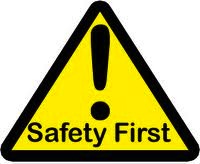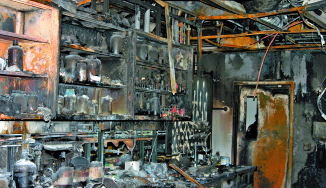 UR Home
UR Home
Lab Safety


"A picture is worth a thousand words"
Destroyed Coleman's lab after an explosion and fire at Ohio State
Chem&Eng News, 2005, 83, 34-35
Laboratory Safety is a very critical aspect of science. Protocols, practices and regulatory issues regarding research are routinely trained and addressed in the private sector, but unfortunately they continue being underestimated in most academic labs. The most serious accidents usually are related to unexpected explosions during a chemical reaction. Although everybody can make mistakes, these accidents usually occur by a lack of knowledge on the hazards associated to specific chemicals and reactions. There is limitless documentation available on Internet that aims to minimize these hazards and explain how should we behave in the case of an emergency in the lab caused by a personal injury, an explosion or a fire.
Herein, we want to emphasize the importance of this theme by listing examples of dangerous procedures that everybody should keep in mind. As a commitment, we will schedule in our group lab safety/learning reports and consequent actions aiming to avoid accidents, as well as to identify and use emergency equipment and protective gear.
Next you can find a compilation of a series of "stories" you should ALWAYS (no excuses) keep in mind during your daily work in the lab.
- UCLA. Tragic accident involving tert-butyllithium
- Explosive Decomposion of an Organic Azide
- Lithium Aluminum Hydride and Tetrahydrofuran Explosion
- Stirred Reaction Flask Explosion
- Chemical Solution Preparation Explosion
- Phenyl Azide Solution Erupts During Vacuum Distillation
- Unintended Overpressurization of Sealed Vial Results in Rupture
- A Bench Scale Chemical Reaction Results in an Explosion
- Gas Cylinder Gasket Melted Due To Reaction with Anhydrous Hydrogen Chloride
- Chemical Container Failure Due to Over-pressurization
- Aqueous Hydrogen Peroxide and Acetic Anhydride Explosion
- Diazomethane Explosion (Org.Proc. Res. Dev. 2008, 12, 1285)
- Magnesium and copper oxide Explosion (J. Chem. Educ. 1994, 71, 328)
- Protic Ionic Liquid Explosion (Green Chem. 2013, Advance Article; DOI: 10.1039/C3GC41328D)
- Texas Tech Laboratory Explosion
- Glass Bottle Ruptures, Possible Reaction of Incompatible Chemical Wastes
- Adding Diaminopropane and Potassium Hydroxide
- Two Explosions Involving Aqua Regia
- Failure to Manually Purge Hazardous Gases
OTHER GENERAL AND VERY USEFUL LINKS
The Importance of Classroom Lab Safety
Online Training Courses on Lab Safety
https://www.safetytraining.nih.gov/Main.aspx
https://www.utexas.edu/safety/ehs/train/
http://www.ehs.psu.edu/occhealth/labsafety.cfm
Identifying and Evaluating Hazards in Research Laboratories
Laboratory Safety Guidance (OSHA)
Explosive and Reactive Chemical Hazards
Fire Safety and Use of Fire Extinguishers: Because fire is the most common serious hazard that one faces in a typical chemistry lab!!
NEW!: House Fires: Prevention, Preparation, and Other Safety Considerations
Remember: Developing a culture of asking yourself “what” and “why” are you doing something EVERYTIME you are working in a lab, will not only have a positive impact in your research, but it will also help you to prevent accidents.


